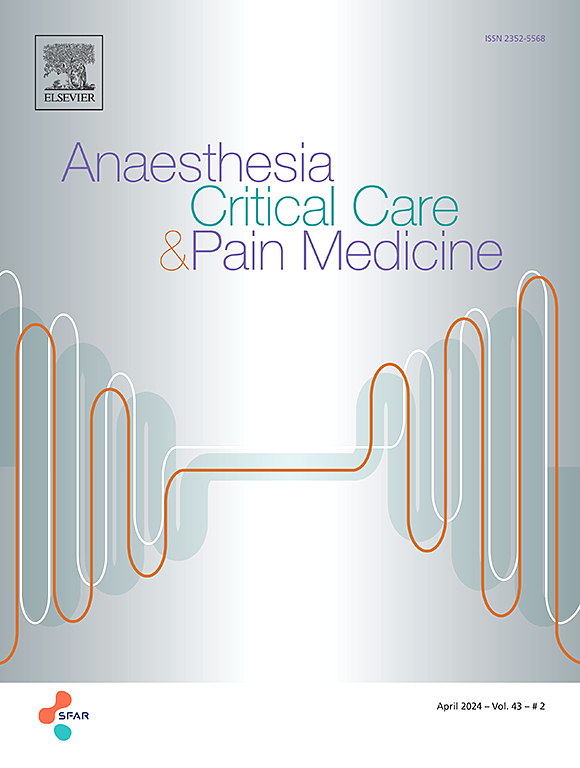Pain intensity after robotic-assisted urological surgery: the PAIROU study an international prospective cohort study
IF 4.7
3区 医学
Q1 ANESTHESIOLOGY
引用次数: 0
Abstract
Objective
Despite improvements in perioperative pain management protocols, severe postoperative pain is still a burden for many patients. To improve the prevention and treatment of postoperative pain, it must be accurately assessed for each procedure type. However, there is little data available assessing the pain levels after robot-assisted urological surgeries. This cohort study aimed to estimate the pain scores that can be expected after various types of robotic-assisted urologic procedures.
Methods
This was a prospective, multicentre, observational trial in 44 centers in Europe that included patients scheduled for robotic-assisted urological surgery. The primary outcome was pain scores on the first day after surgery assessed using the numeric rating scale (NRS). Secondary outcomes included pain score on the second day after surgery, morphine equivalent consumption in mg 48 h after the surgery, postoperative nausea and vomiting (PONV), and surgical complications.
Results
A total of 965 patients were recruited between November 2022 and June 2023. Median pain score on postoperative day 1 was 2 at rest (IQR, 0–4) (n = 963) and 3 with movement (IQR, 1–5) (n = 921). Morphine equivalent consumption 48 h after the surgery was 4 mg (IQR 0−20 mg). PONV was experienced by 16 % of the patients (153/963).
Conclusion
This large cohort study demonstrates that patients experience low pain scores and require low opioids after robotic-assisted urological surgery when commonly used multimodal analgesia protocols are administered.
Trial registration
clinicaltrials.gov No. NCT05575284.
机器人辅助泌尿外科手术后疼痛强度:PAIROU研究一项国际前瞻性队列研究。
目的:尽管围手术期疼痛管理方案有所改进,但严重的术后疼痛仍然是许多患者的负担。为了更好地预防和治疗术后疼痛,必须对每种手术类型进行准确的评估。然而,很少有数据评估机器人辅助泌尿外科手术后的疼痛程度。本队列研究旨在评估不同类型机器人辅助泌尿外科手术后的疼痛评分。方法:这是一项前瞻性、多中心、观察性试验,在欧洲44个中心进行,包括计划进行机器人辅助泌尿外科手术的患者。主要结果是术后第一天的疼痛评分,采用数字评定量表(NRS)进行评估。次要结局包括术后第2天疼痛评分、术后48小时吗啡当量消耗(mg)、术后恶心呕吐(PONV)和手术并发症。结果:在2022年11月至2023年6月期间,共招募了965名患者。术后第1天疼痛中位评分为静止时2分(IQR, 0-4分)(n = 963),运动时3分(IQR, 1-5分)(n = 921)。术后48小时吗啡当量消耗量为4 mg (IQR 0 ~ 20 mg)。16%的患者(153/963)出现PONV。结论:这项大型队列研究表明,当采用常用的多模式镇痛方案时,机器人辅助泌尿外科手术后患者的疼痛评分较低,需要的阿片类药物较少。试验注册:clinicaltrials.govNCT05575284。
本文章由计算机程序翻译,如有差异,请以英文原文为准。
求助全文
约1分钟内获得全文
求助全文
来源期刊

Anaesthesia Critical Care & Pain Medicine
ANESTHESIOLOGY-
CiteScore
6.70
自引率
5.50%
发文量
150
审稿时长
18 days
期刊介绍:
Anaesthesia, Critical Care & Pain Medicine (formerly Annales Françaises d''Anesthésie et de Réanimation) publishes in English the highest quality original material, both scientific and clinical, on all aspects of anaesthesia, critical care & pain medicine.
 求助内容:
求助内容: 应助结果提醒方式:
应助结果提醒方式:


